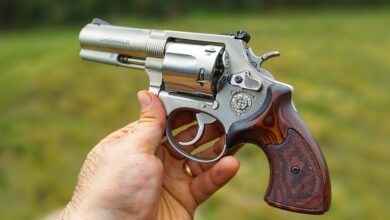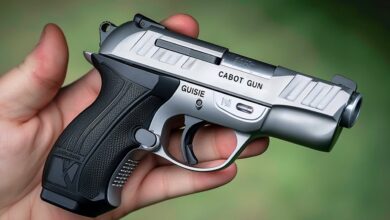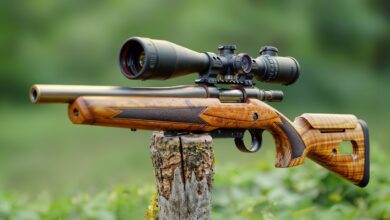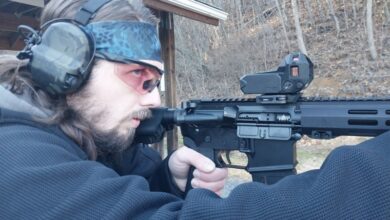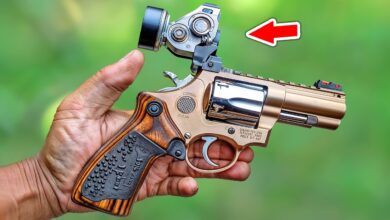Scoping a Ruger 10/22 Carbine: Is It Realistic?

Every now and then, a friend will ask me a question about firearms. For some reason, they think that I’m knowledgeable. To be fair, I guess I know more than some but less than others about such matters.
So, a couple of weeks ago, a good buddy asked if I thought it would be worth it for him to mount a scope on his Ruger 10/22. I had to pause and consider for a moment. What was I considering?
Define The Mission
I always ask the person, “What are you expecting to do with the rifle?” His answer was that he wanted it to be more accurate at a longer range, mostly for target shooting and self-defense. He also might consider the rifle a long-term survival arm with which to hunt small game should society take a turn for the worse.
My buddy is not someone who started shooting shortly after exiting the womb. As such, he likes to use scopes on his long guns because they increase his ability to hit targets beyond 35-50 yards. Specifically, he wants to be able to place his shots precisely.
The above missions are rather broad in scope.
The Platform
The Ruger 10/22 is a cult classic in the firearms industry, with many households owning one or more of these slick little carbines. First introduced in 1964, well over seven million 10/22s have been manufactured so far, and Ruger doesn’t seem to have any plans of stopping any time soon. And why would they?
The little rifle is wildly popular for good reason. They are compact, lightweight, reliable, and accurate. We’ll see just how accurate shortly.
In a world where many .22 caliber semi-auto rifles exhibit spotty reliability, the 10/22 is not one of them. This rifle enjoys excellent reliability, and you’d be hard-pressed to find a .22 rifle with more reliability than the Ruger.
Magazine Availability
Another advantage is the availability of Ruger magazines. Initially, the 10/22 came with a 10-round rotary magazine that fits flush with the underside of the stock. These have been the standard since the rifle’s inception, and they’re still going strong today for a couple of reasons. First, they simply work. They don’t add anything hanging out of the bottom of the rifle, so shooting the rifle prone or from a rest is easy. Finally, those who live in less free areas of the United States and around the world are often limited by how many rounds their firearm can hold (and that magic number is, for some reason, usually 10 rounds). Finally, the little 10-rounders are very compact and handy, so it’s easy to carry a handful of them on our person.
If 10 rounds doesn’t blow your hair back, that’s not a problem these days, as Ruger offers factory 15 and 25-round magazines. They’re reasonably priced and extremely reliable, as well as being durable. These are your best bet for upping the ammo capacity of the little Ruger. But wait, that’s still not enough capacity? Then check out GSG’s 110-round drum! I’ll give you a spoiler: it unloads a lot faster than it loads, but it’s fun!
Operation
The Ruger 10/22 operates with a blowback action. The standard rifle weighs around five pounds and is roughly 37 inches in length. Receivers are made from aluminum alloy, and the barrel is normally 18.5 inches long. American walnut stocks are available, although various stocks can be had, including those that are synthetic. In fact, the 10/22 has a staggering amount of different configurations that have come up over the years, from pistol variants (the Charger) to compact versions, to take-down models, target models, and varmint hunters. You name it, they’ve done it to the 10/22!
And if you like accessories, an entire cottage industry of aftermarket doo-dads exists for the 10/22. Stocks, barrels, triggers, optics, suppressors…every part that exists for the rifle has an aftermarket counterpart.
Sufficient Accuracy?
All of these things are well and fine, but the question boils down to this: Does the rifle have enough accuracy to actually use a scope? Before embarking on this little project, my pal was adamant about wanting the scope for it.
And he had a point, reasoning that no matter what the accuracy potential was, he would improve his ability to accurately place rounds on target by scoping it out. Neither of us had any illusions of turning a stock 10/22 into a sniper rifle; that would be silly. Sometimes “better” is…well, good enough.
And so we soldiered on. A scope was ordered, as were rings and a Picatinny rail. They arrived and were dutifully mounted.
The Scope
I should take a moment to elaborate on the scope of choice here. The scope maker is Vortex Optics, a brand that I’m very familiar with. In fact, I suggested it as one of the choices that my friend might want to consider.
He selected the Crossfire II 2-7x32mm Rimfire Rifle Scope.
Before I get into scope specifics, a quick word about Vortex. They began making binoculars in 2002 before expanding to rifle scopes, rangefinders, spotting scopes, tripods, and a host of other gear. Fast-forward to present times, and they have over 300 employees and an ever-growing product catalog.
I own several of their products (and they don’t pay me to say any of this) that I’ve found to be very good gear. I have one phenomenal spotting scope and a few rifle scopes, all of which are good quality and have given excellent performance.
They also have a lifetime, no-questions-asked warranty. I had to use it once for an issue that I was having with one of their scopes. They handled the matter in a most friendly manner, and before I knew it, I had a scope headed to my house with instructions that I should use the box to return the broken scope with the included return postage. They could literally not have handled the matter any faster or more professionally than they did, and I was ecstatic at how fast and pleasantly I was treated. Their warranty and customer service are seriously the real deal.
Scope Specs
Let’s take a gander at the technical specifications of the Crossfire II 2-7x32mm scope.
- Overall Length: 11.52 inches.
- Overall height: 1.61 inches.
- 13.9 ounces.
- Objective lens: 32mm.
- Reticle: V-Plex.
- Magnification: 2-7.
- Tube size: 1 inch.
- Adjustment graduations: 1/4-MOA.
- Max Windage Adjustment: 60 MOA.
- Max Elevation Adjustment: 60 MOA.
- Field of View: 42 to 12.6 Feet at 100 Yards.
- Eye Relief: 3.9 inches.
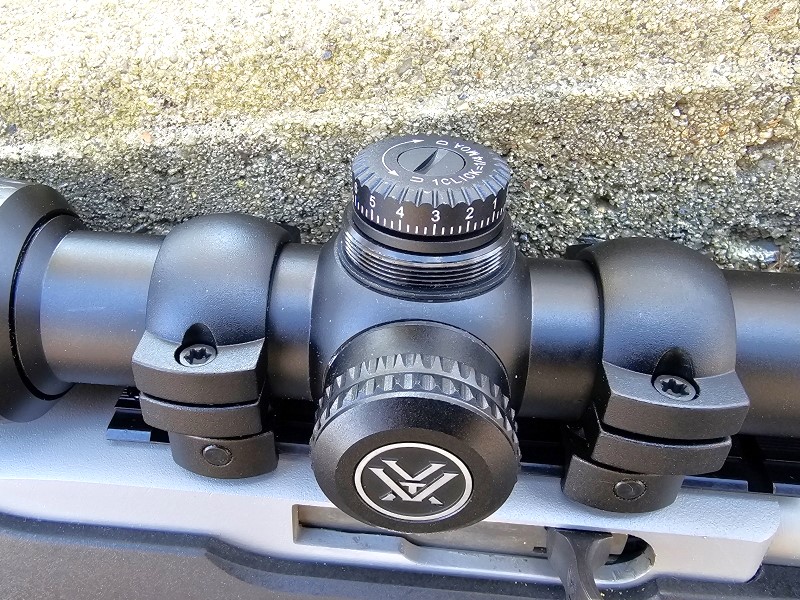
Overall, this is not a huge, heavy scope. It’s not tiny, but it’s realistic for a .22 caliber rifle. The tube is constructed from aircraft-grade aluminum, so it’s strong. The lenses are coated with Armor Tek, so they are protected from scratches and other damage. Vortex also states that the scope is shockproof.
The reticle is a pretty standard duplex type, with heavy crosshairs that become thinner toward the center. This is a good overall crosshair, and it’s refreshingly simple in that it’s not as cluttered as some of those we’re seeing these days. Manufacturers seem to be thinking that the more cluttered they can make a reticle, the better.
Overall, this is a very basic, straightforward scope that’s easy to use. The windage and elevation turrets have screw-down caps, and they are of the tactical type in that there are numbers so shooters can record the various settings at different ranges if they desire. The scope settings were positive and easy to adjust.
The scope also offers a clear view through the glass, which is essential for a good scope.
On The Rifle
In short order, we had the scope mounted on the Ruger 10/22. It’s worth noting that the scope’s proportions to the rifle were realistic and good. What I mean by that is the scope wasn’t too huge for the rifle. Sometimes, people get a scope mounted and think, “Jeez, this thing is gargantuan; I shouldn’t have mounted such a huge scope on a little rifle.” That’s not the case here; it’s compact and light enough that it works with the 10/22. With that said, I wouldn’t want to go any larger than the Crossfire II, as that would cross over into the “Too Large” category.
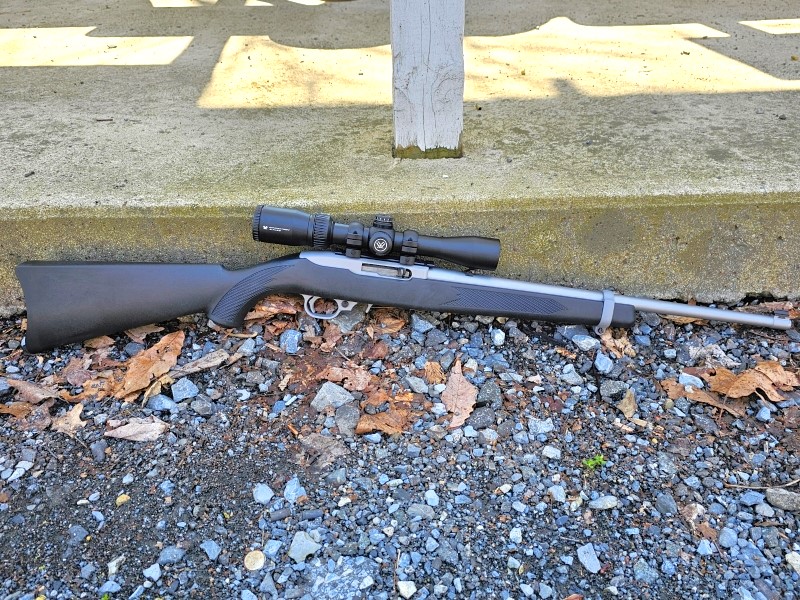
Accuracy
Here’s the part we’ve all been waiting for – just how accurate is the 10/22?
To make a long story short, the 10/22 slightly exceeded our expectations. One of the better groups we achieved was with CCI copper-plated solid 40-grain bullets, which delivered a nice 3/4-inch group at 50 yards.
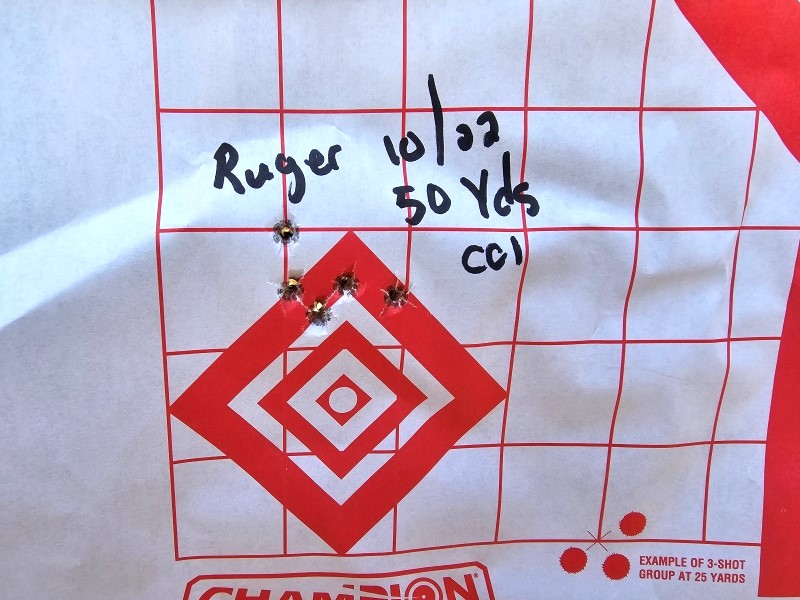
For this range session, we limited the shooting to 50 yards for a few reasons. First, we were sighting the scope in, which didn’t take terribly long. Secondly, we thought 50 yards was a realistic expectation for the little .22’s use. Had we more time, we’d have stretched it to 75 and then 100 yards, which will happen in future shooting sessions. Hitting a man-sized target at 100 yards is one of the requirements that my friend has since he considers the Ruger 10/22 viable for self-defense in a pinch (no, it’s not his primary defensive rifle). With the scope set on a low power, the field of view is wide enough that hostiles could be engaged fairly closely.
The fact that .22LR can be stockpiled inexpensively is a major motivator. Another huge advantage is that a healthy supply can be carried without weighing you down.
That 3/4-inch group was pretty representative of what we got throughout our range session. The CCI ammo proved to be the most accurate of a few other brands we had along for the day. We didn’t have any match ammo on hand to try, but then, the 10/22 in its basic form isn’t a match rifle.
Conclusions
At 50 yards, the 10/22 gave us a bit more than we were expecting in terms of accuracy, which made us happy. It certainly would take small (or medium) game with proper shot placement. Consider that many deer poachers use the .22 to take deer at night – again, perfect shot placement is the key here. And no, I don’t advocate doing such illegal activities, but it’s an illustration of what the little .22 is capable of accomplishing under certain circumstances.
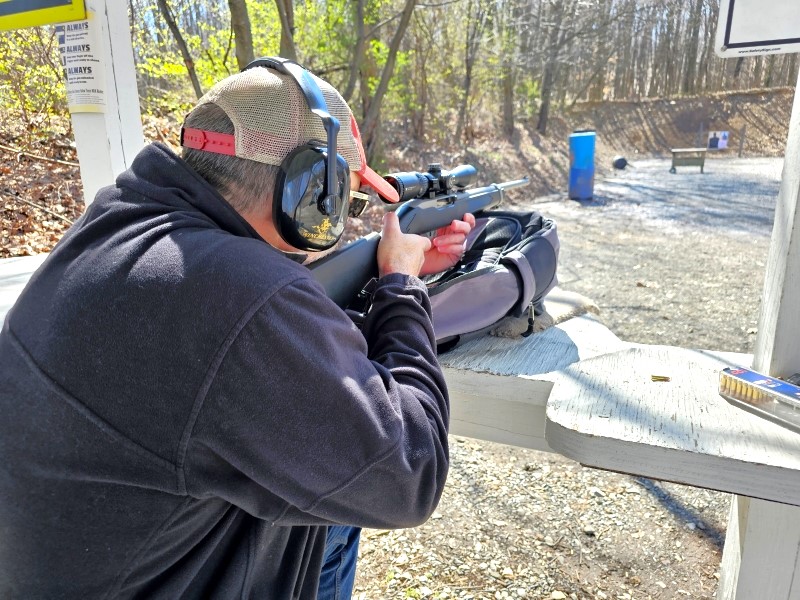
We spent a couple of hours shooting for a very small fee, given the inexpensive price of .22 Long Rifle ammo. It made sighting in the scope a lot less painful on the wallet. We even joked, “Can you imagine what this would have cost if we were sighting in a .30-06?” It’s a valid point.
So, was it worth scoping the little Ruger 10/22?
Well, the rifle itself is rather economical (most can be had right around the $300 mark in gun shops). The scope isn’t an expensive one, selling for about $129.99 as this is written. The mount and rings were inexpensive as well. And then there’s the ammo, which is pennies per round.
This is all for a rifle that will turn in some pretty small groups at realistic distances. In our opinion, it was definitely worth scoping the 10/22. The scope won’t make the rifle “more accurate,” but it will allow us to shoot it more accurately.
The post Scoping a Ruger 10/22 Carbine: Is It Realistic? appeared first on The Mag Life.
Read the full article here

